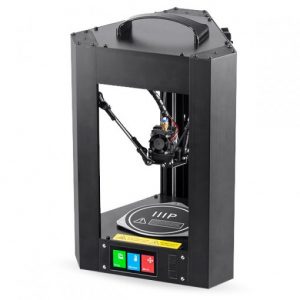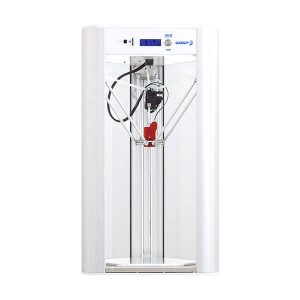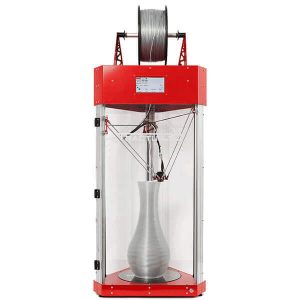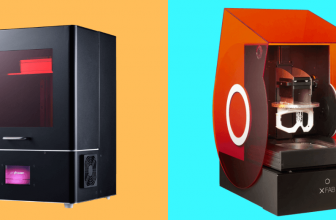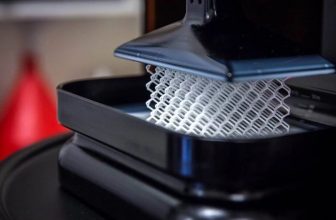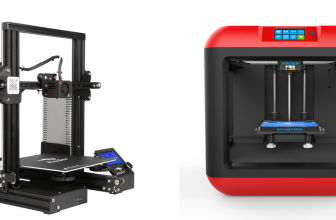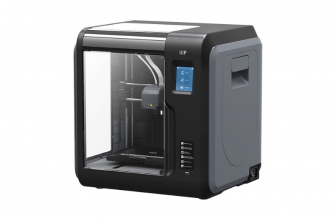What Are Delta 3D Printers?
A delta printer prints in an orderly manner. It has three trigonometrically moving arms that move up and down. They pinpoint the exact location of the printing head, which is often small and light. When compared to competing printers, Delta printers are much faster.
Another advantage of this printer is that, due to its natural construction and design, it can produce tall models. The models are printed on non-moving print beds, which makes the process more stable.
They often provide less detailed finishes due to their nature as a fast-printing 3D model. When it comes to the sorts of filaments that can be used, most Delta printers have a relatively limited capacity.
Delta 3D printers are beneficial for everyone, from artists to homemakers. Regardless of your reason for using it, the best delta printer will provide you with the highest level of precision, versatility, print speed, and efficiency. We’ve ranked the top delta 3D printers on the market based on these criteria.
Delta printers are, without a doubt, the best 3D printers on the market. These futuristic models have been a public favorite for obvious reasons, as they have altered the entire 3D printer business.
Delta 3D printers, unlike Cartesian versions, are thin and tall. As a result, they are more adaptable to various jobs.
Advantages
- Printing that is quick and efficient. Print speeds of up to 300 mm/s are relatively uncommon and can still produce excellent results.
- Improved print quality. This is a questionable statement as it all relies on the type of printing you’re doing and how well you know your printer. Jerk and acceleration are reduced while printing due to the lightweight extruder and fixed bed, which help smooth out print irregularities at low speeds.
- Printing is mesmerizing. One of the main reasons people buy deltas, believe it or not, is that they look cool. On a cold night, wrap up in a blanket, sip some hot chocolate, and watch the small thing disappear.
Disadvantages
- There is a limited building area available. The constructed space on Deltas is modest but lofty and cylindrical. Depending on what you wish to print, you may rapidly run out of space. If you don’t intend to use the printer’s incredible height, you might want to stick with a Cartesian printer instead.
- Troubleshooting is difficult. In comparison to its Cartesian equivalent, the delta 3D printing community is quite limited. You won’t have as much of a knowledge foundation to draw on if you have a query about fine-tuning your printer or where to buy spare components.
Comparison Chart
| Name | Link | Nomination | Rating |
|---|---|---|---|
| Monoprice Delta Pro | Versatility | 7 | |
| Monoprice Mini Delta | Cost-effective | 8 | |
| Wasp DeltaWASP 2040 Pro | Large Size Print Production | 8.6 | |
| FLSUN QQ-S Pro | High Speed Printing | 8 | |
| FLSUN Q5 | Reliability | 9 | |
| Frankensbox FX-800 | User-friendly | 7.2 | |
| He3D K280 Delta | High Precision | 9 | |
| Tractus3D T1250 | Affordable | 8.7 | |
| Delta Wasp 4070 Industrial X | User-friendly | 8.3 | |
| Anycubic Predator | Time Saving | 8.7 | |
| Anycubic Kossel Linear Plus | High precision and quality prints | 7.2 | |
| CoLiDo D1315 Plus | High Speed Printing | 8.2 | |
| BIQU Magician | Affordable | 10 | |
| SeeMeCNC Rostock MAX V4 | Powerful Printing | 9.8 | |
| UltiBots D300VS | High Quality Printing | 8 |
Catalog of Best Delta 3D Printers
Monoprice Delta Pro
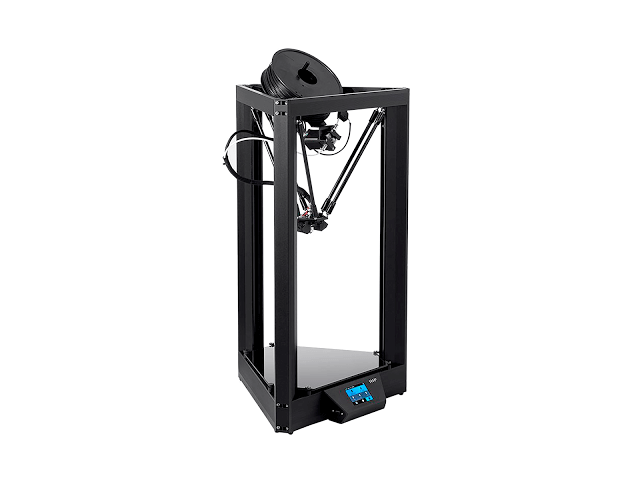
The Monoprice Delta Pro is a large-format delta 3D printer with excellent print quality, particularly when properly calibrated. Delta-styled 3D printers, although being the less popular alternative, have a few advantages over their Cartesian counterparts.
The circular bed design makes better use of the entire build volume and, in most cases, it allows you to print taller items. Another advantage is that Delta printers can print at higher speeds, which is especially important for manufacturers who need to get things done quickly.
Uses:
- Starting with the Delta Pro’s most amazing feature, this delta 3D printer has a big build capacity of 270 x 300 mm (10.6 x 11.8 inches).
- For a more intuitive user experience, use the touchscreen.
- To avoid time-consuming manual calibration, automatic leveling is used.
- Wi-Fi connections allow users to remotely manage their 3D printers.
- Build on a heated glass print bed that has auto-leveling for a consistently flat surface. ABS, PLA, Nylon, and PETG are among the filaments that can be printed thanks to the heated print bed and high-quality hot end.
- The MP Delta Pro comes with a slew of premium features that make life easier for customers.
- Easy to use
- Auto bed leveling
- Remote connectivity
- Pricey
Monoprice Mini Delta
|
With the addition of this printer, Monoprice joins FLSUN as the second company to have multiple printers in our catalog.
It’s amazing how Monoprice manages to include a sturdy steel and aluminum frame in the Mini Delta, despite the printer’s low price! Not only does it have a sturdy frame, but it also has a heated bed that allows you to print with ABS and PLA.
All of this, combined with the fact that the printer comes completely constructed and requires no DIY experience, makes it one of the finest Delta 3D printers to buy.
Uses:
- The Mini Delta is capable of producing parts with a 50-micron resolution. Wi-Fi, SD Card, and USB are all options for connecting to the printer.
- It has a maximum construction volume of 110 mm x 110 mm x 120 mm and a maximum build volume of 110 mm x 110 mm x 120 mm. It can be accelerated to 150 mm per second.
- The temperature ranges of the nozzle extruder and the print bed ensure that you can operate flawlessly with ABS and PLA filaments from various manufacturers.
- The auto-calibration feature also assures a quick bed leveling process.
- The kit is also fully constructed, so all you have to do is unpack it and start printing with the reloaded MicroSD card, which contains printable sample 3D models.
- It also offers a lot of upgrade potential.
- A 161-MB SD card is included.
- Relatively inexpensive
- The print bed is simple to clean
- Cartesian models are twice as quick as non-Cartesian models.
- For first-timers, it’s a little challenging.
- There isn’t even a power button.
Delta WASP 2040 Pro
|
Within the FDM desktop 3D printer category, the Delta WASP 2040 Turbo 2 is regarded for being one of the quickest printing machines. Since its introduction in 2017, the printer has undisputedly held this position.
The Delta WASP 2040 TURBO2 is available in a black and grey color scheme, which is both elegant and practical for a number of professional applications.
The printer measures 490 x 440 x 870 mm and weighs 20 kg. The printer is pre-assembled, so all you have to do is plug it in and begin printing.
Uses:
- This printer has an updated control board that can operate the Red Extruder’s optional twin print head or the high-flow rate Spitfire extruder.
- The printer’s sliding mechanism has also been upgraded to improve the printer’s speed and precision.
- Users can save and resume their 3D print with the resurrection functionality. The resurrection system, which is especially useful in the event of a power outage, is an extension of the Stop and Save function.
- The chamber insulation improved as the cooling for the motors and board improved.
- Turbo 2 can print sophisticated materials at incredible speeds up to 350o C.
- An SD card is used to save the coordinates on which you are currently extruding.
- The printer does not need to be calibrated manually and can be calibrated automatically based on the part or functional prototype being printed.
- This printer’s extruder can handle materials with a lower density. This functionality is not available on other printers.
- This printer has a quick print speed.
- High print temperatures, making it feasible to print with materials that do not melt at low temperatures.
- The Delta Wasp 20 40 Turbo 2 is a tough and dependable machine.
- When printing with this printer, dual extruders are an option.
- Can print with the use of third-party filament support.
- Beginners may find the price of this printer prohibitively high. It is significantly more expensive than DIY kits.
FLSUN QQ-S Pro
|
The QQ-S 3D printer by FLSUN is an improved version of its predecessor, the QQ Pro. Only about half a year after the release of its predecessor, the FLSUN QQ P, the Chinese company has introduced the FLSUN QQ-S, which is a slightly enhanced version with certain tweaks and additions. The QQ-S, like its predecessor, is a low-cost Delta printer.
Uses:
- FLSUN touts the QQ-S’ innovative Lattice Platform, which is said to be a high-strength lattice composite covering that allows for faster heating and less warping, as well as strong adherence throughout the print and easy removal once the print is finished and the bed has cooled.
- The filament is fed smoothly into the extruder, which enables powerful extrusion.
- The printer is entirely built of stainless steel (SAE 304), resulting in less wobbling and, as a result, more precise prints.
- The QQ-S has an operating noise of less than -50 dB, making it acceptable for use in offices, according to the manufacturer.
- The print bed of the FLSUN QQ-S can reach 100o C in less than five minutes. It may reach a maximum temperature of 270o C.
- Because of the higher temperature resilience, you may print with a variety of materials, including PLA, ABS, and PETG.
- The touchscreen interface on the QQ-S allows for easy use.
- Auto-leveling of the bed.
- Printing speed is excellent.
- The print quality is exceptional.
- There is a significant amount of build volume.
- Titan extruder.
- A 32-bit motherboard is required.
- Certain delicate parts and working prototypes are difficult to produce due to the non-moving print head.
FLSUN Q5
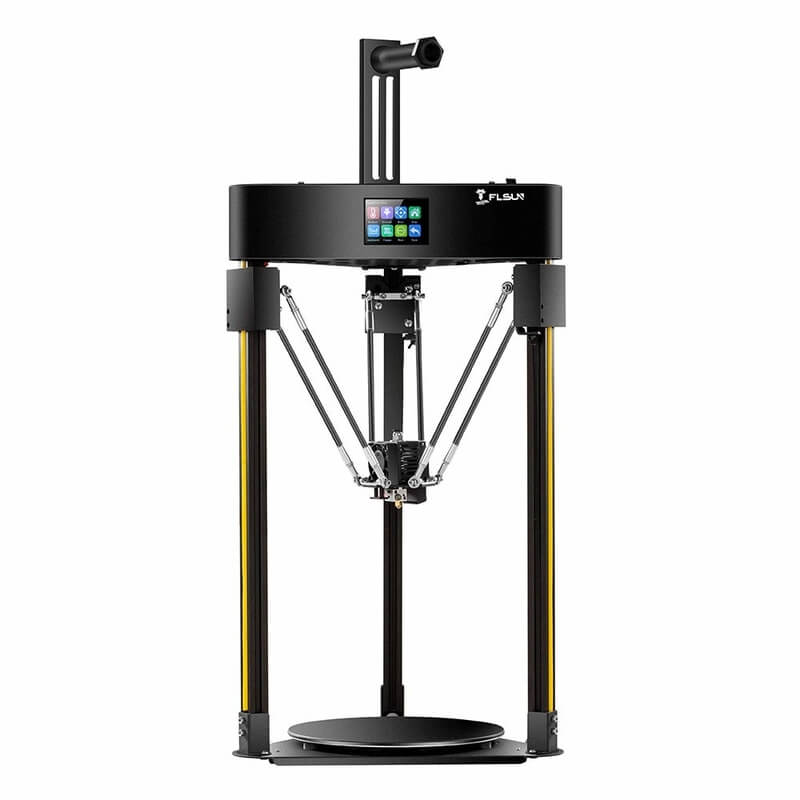
The FLSUN Q5 is the most recent addition to the FLSUN family, and it is shaping up to be something along the lines of an entry-level printer for the Chinese company, undercutting the price of its larger sibling – the QQ-S – by roughly $100. However, customer feedback on this printer has been positive, which is a good sign for that type of consumer.
Uses:
- Automatically detects 27 locations and allows for real-time nozzle height adjustment and compensation.
- Filament feeding is smooth, and extrusion is vigorous.
- It comes standard with a 0.4 mm extrusion nozzle, but it can also accept 0.2 mm and 0.3 mm nozzles for fine prints.
- The QQ Mini can handle all major print filaments, including ABS, PLA, PVA, and wood, at a maximum temperature of 270° C. However, flexible materials and HIPS support materials are also available.
- It has a 32-bit motherboard and a separate MOS module, so it can print at high speeds while being stable.
- With a touchscreen and Wi-Fi connection, it can restart printing from a breakpoint, save in the event of a power loss, detect filament outage, and turn off automatically once printing is complete.
- Overall, it’s pretty much everything you could want from an operating system.
- The printer is entirely built from stainless steel (SAE 304), resulting in less wobbling and, as a result, more precise prints.
- The QQ Mini has an operating noise level of fewer than 50 decibels, making it ideal for use in offices.
- Good quality prints
- Offers good speed
- Noisy
- Printing fails in case of temperature change
Frankensbox FX-800
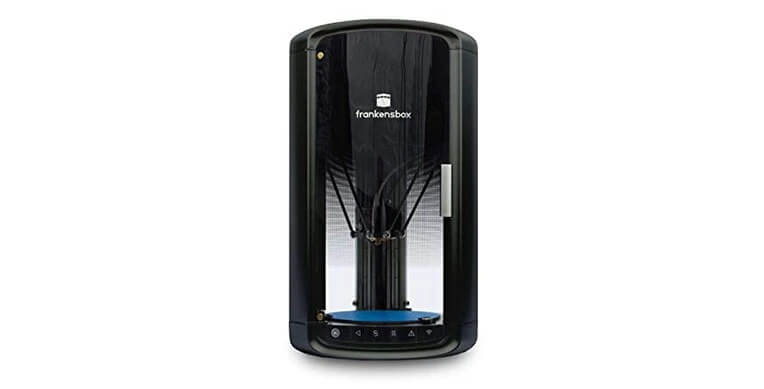
The FX-800 is one of the most reliable entry-level delta 3D printers. It comes completely constructed and with one-button leveling functionality, making it an excellent choice for 3D printing beginners with minimum technical knowledge.
In addition to great print quality, the FX-800 can print a wide range of materials. Because it has an enclosed printing chamber, it is also suitable for a variety of more difficult materials.
Uses:
- The FX-800 has a sophisticated appearance. It has a maximum volume of 5.9 x 5.9 x 6.9 inches and can print three-dimensional items with a maximum volume of 5.9 x 5.9 x 6.9 inches.
- This 3D Printer is really simple to use. Before using the product, you don’t have to deal with any complicated settings.
- Wireless communication between the 3D printer and Android and iOS devices is possible. It can also connect to your other computers and connect to the internet.
- Works on both Mac and PC platforms
- The printer is really quiet.
- The nozzle can reach temperatures of up to 250o C.
- The printing dimensions are 150 x 150 x 175 mm.
- Printing speeds of up to 150 mm/s are possible.
- You may print from iOS, PC, Mac, or the supplied Micro SD card.
- The spool holder on the top is quite small.
- Doesn’t have a manual or user guide.
He3D K280 Delta
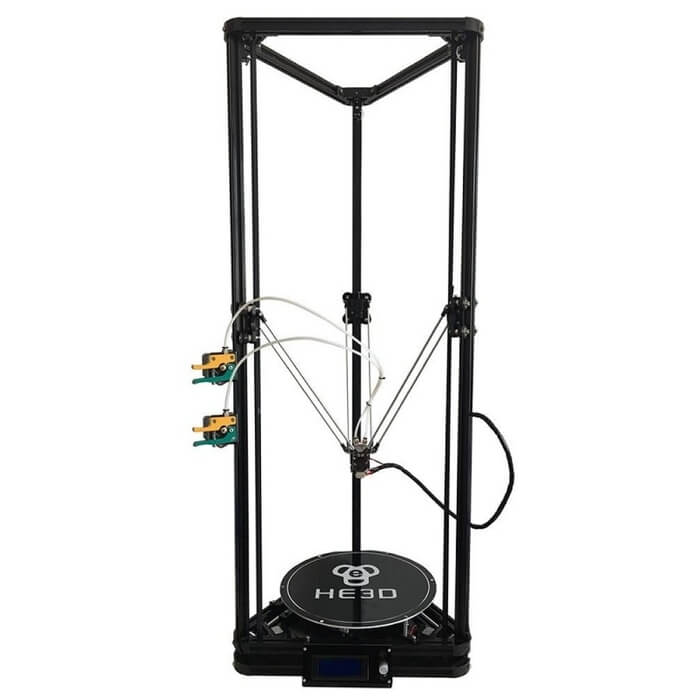
HE3D is an online tech store founded in 2013. HE3D’s K280 3D printer is a DIY / Kit affordable 3D printer. HE3D is a Chinese 3D printer company. The HE3D K280 uses extrusion 3D printing.
It has specialized in 3D printing technology, ensuring that its global customer has access to the most up-to-date information. A print bed and a tight metal frame characterize the HE3D K280 Delta 3D Printer.
The frame is made of an aluminum and steel alloy that is extremely durable and heat resistant. The movements are rather fluid once combined, allowing for optimal printing precision.
Uses:
- The build volume of this 3D printer is 280 x 280 x 600 mm.
- The printer’s speed and heat tolerance distinguish it from the competition. Within two minutes, it reaches 110o C.
- The delta 3D printer also includes a 24V power supply that provides backup for 12 hours.
- The print head comprises copper, aluminum, polyether, and ketone. As a result, even during protracted projects, the print output remains consistent. The alloys are extremely tough and long-lasting.
- Despite the fact that there are less expensive alternatives, the HE3D K280 is the best delta 3D printer due to its power output and print range. It can print diameters ranging from 280 to 600 mm. This one can be used by both professionals and amateurs.
- With a great thermal runway, the best delta 3D printer is available.
- Easy to assemble.
- Customer service that is responsive.
- Exceptional calibration printing.
- The sound of rattling is deafening.
- A z-probe is not included.
Tractus3D T1250
|
The T1250 will astound you with its affordability. It has the highest layer resolutions of any 3D printer in its pricing range, which other 3D printers in the same price range can’t match.
T1250 has a height of 154 cm, a width of 600 mm, and a diameter of 350 mm. Overall, it’s a decent 3D printer that can produce high-quality drawings and prototypes directly on your desk.
Uses:
- The heated build platform of the T1250 decreases the risk of inaccuracy while printing the first layers of any part of a working prototype. It also aids in the adherence of the first layers laid down on top of it.
- The first layer matching with the 3D design file is one of the most important aspects of any part or functional prototype manufactured utilizing 3D printing. And the precision of this depends entirely on how well the printer’s print bed is leveled.
- The maximum build width on the T1250 is 350 mm, and the maximum construction height is 600 mm.
- It uses 3D printing technology known as fused filament fabrication or fused deposition modeling.
- The X, Y, and Z axes of the Tractus 3D T1250 each have a resolution of 10 microns.
- This 3D printer can 3D print a part of a functioning prototype at a maximum speed of 300 millimeters per second.
- A seven-inch touchscreen is located on the printer’s body, and it supports Dutch, French, and German in addition to English.
- This 3D printer uses a heated glass build plate with a PEI sheet as the build plate material. It can withstand temperatures ranging from 10 to 120o F.
- The Delta-type structure allows you to print at a considerably faster speed and has an automatic bed leveling functionality.
- A heated build plate is included with the printer.
- The seven-inch multilingual touch screen user interface improves your contact with the 3D printer.
- Not entirely accurate.
Delta Wasp 4070 Industrial X
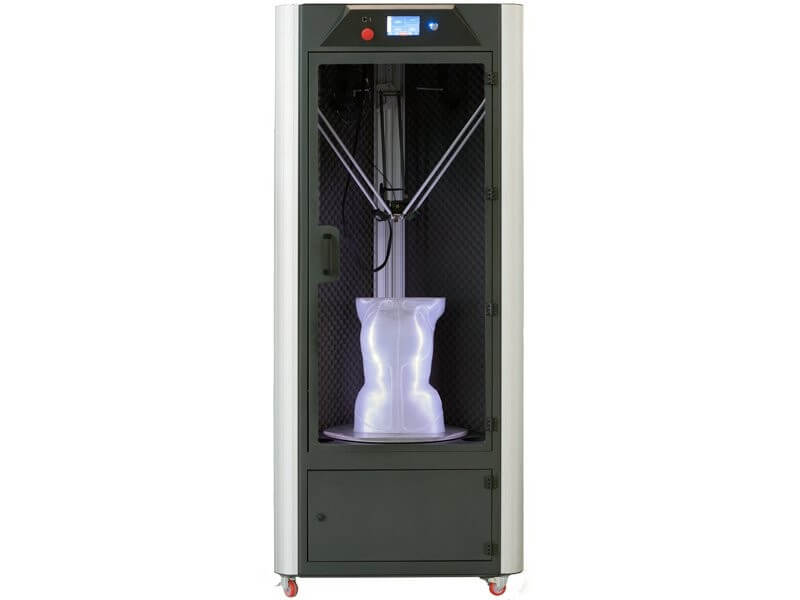
A professional FDM 3D printer, the Delta WASP 4070 Industrial X is an enhanced version of the normal 4070 Industrial 4.0 that prints at a much faster rate.
The 4070 Industrial X is entirely composed of metal and uses temperature-resistant steel cord belts. It comes completely constructed and packaged in a wooden box.
Uses:
- The 4070 Industrial X, like its predecessor, has an auto-calibration system, an open-door security sensor, and an end-of-filament detector.
- It has a “hot and cold” build chamber, a Wi-Fi module for remote control, and an onboard camera to view your print jobs in real-time.
- It also has a Filament Driver X with two hardened steel gears and a gearbox, allowing for more efficient printing.
- In the event of a power loss, the handy resurrection function allows you to save your print data and resume your task. When print recovery isn’t an option, the Free Zeta System allows you to pre-select a height at which the print will begin.
- In the event of a malfunction, the machine can display on-screen troubleshooting video instructions.
- The Delta WASP 4070 Industrial X has been used for prototype and small-scale manufacturing with great success.
- Filament driver with two grips.
- Auto-leveling of the bed.
- UI has been improved.
- There is a myriad of connectivity possibilities available.
- Customers may find it a little expensive.
Anycubic Predator
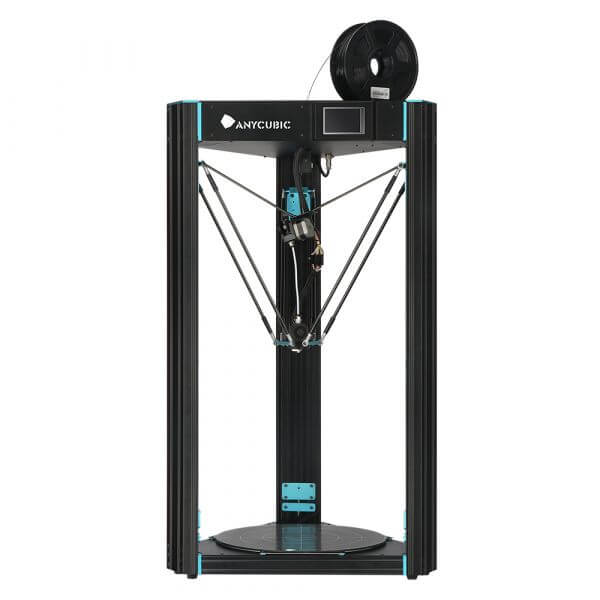
The Anycubic Predator is the company’s newest Delta printer. Anycubic, a 3D printer company based in Shenzen, China, has earned a name for itself in the world of 3D printing.
Uses:
- With a build space of 370 x 370 x 455 mm, the Anycubic Predator has one of the largest build volumes of any Delta printer on the market.
- Due to a layer of porous coating, it provides strong adhesion during printing while also allowing you to easily remove the print once the platform has cooled down.
- While the AnycubicsUltra base is compatible with third-party printers, it does not support auto-leveling or a filament sensor that alerts you when the filament is running out or is damaged.
- In case the power goes out, the machine will resume printing without wasting time.
- Great build volume.
- The thin glass layer on top of the plate can be difficult for some sensors to detect.
Anycubic Kossel Linear Plus
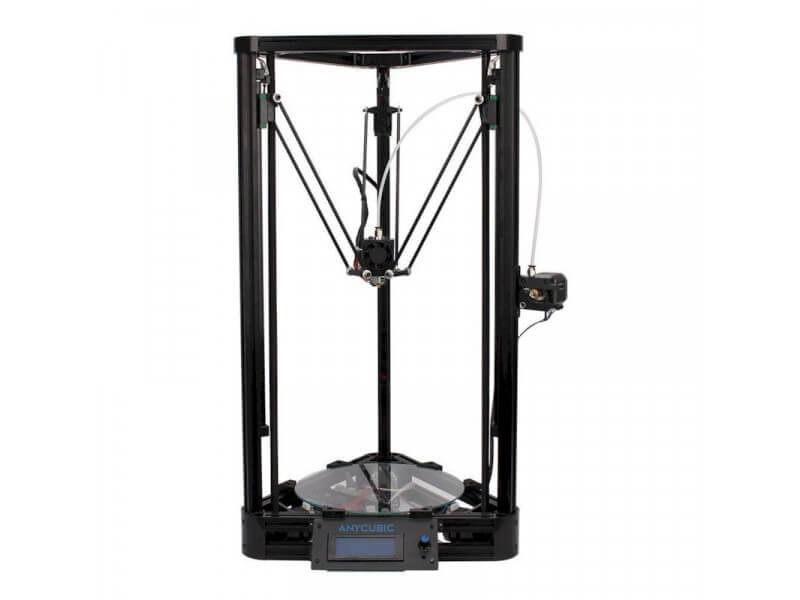
The Kossel 3D printers by Anycubic are well-known. There are several variations, including a pulley version (which we shall describe here), a linear version (which has rails on the carriage instead of wheels), and the Linear Plus (which has a lesser height but a greater diameter). At this pricing point, the Anycubic Kossel 3D printer has a lot to offer its users.
Uses:
- This is a solid 3D printer with excellent frame quality. This is due to the printer’s all-metal chassis, which gives it a rugged appearance.
- The Kossel 3D Printer is extremely durable and robust. You may print longer pieces with this printer. Yes, in terms of height, you get a larger room. It’s also significantly more than the machine’s diameter.
- The good news is that the 3D printer has updates available. Many of these updates can even be found on the internet. As a result, you can print them and improve your machine’s functionality.
- Despite the lack of a touch interface, users can make changes to the printer’s settings directly from the printer. The control panel for the 3D printer is located on the front of the machine.
- The nicest part about the 3D printer is how small it is and how easily it can fit next to your work table. As a result, you can work while concurrently checking the status of your prints to avoid any issues.
- You can only work with one color or filament.
- The print quality is incredible.
- Works well with PLA and is reasonably priced.
- Excellent client service
- Upgrades are available.
- It’s tough to get the bed level, as this printer lacks auto-leveling.
- There isn’t any Wi-Fi support.
CoLiDo D1315 Plus
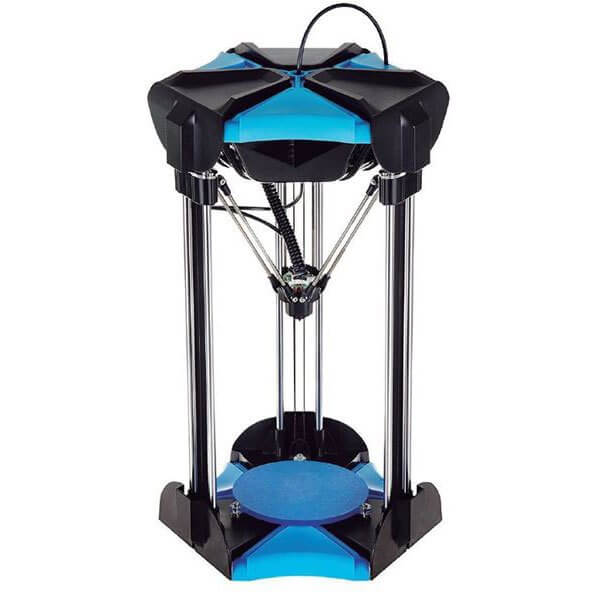
The Delta D1315 3D printer from CoLiDo is designed for ease of use and speed. So, if you enjoy seeing the difference between idea and reality in a short amount of time, the printer is for you.
The D1315 is a desktop 3D printer from CoLiDo, a Chinese manufacturer. Because of its delta structure, the printer has a circular construction plate.
Uses:
- If you are a power-conscious user, the CoLiDo D1315 Plus will not let you down, with only 30-watt consumption.
- Maximum print volume of 130 mm × 130 mm x 150 mm
- PLA may be printed, with a layer resolution of 50 micrometers on produced items and working prototypes.
- Lacquers will not be required for proper adherence and removal of the component thanks to the components that make up the platform of this 3D printer.
- The CoLiDo D1315 Plus 3D printer prints in record time and with great precision thanks to its simple design and unprecedented speed provided by its light-moving parts.
- Anomaly in print speed.
- Power consumption is low.
- The extruder nozzle is not removable to clean.
BIQU Magician

The Magician is a fully completed delta 3D printer based on the Rostock RepRap design, produced by BIQU, a brand name of Chinese company BIGTREETECH (situated in Shenzhen).
The BIQU Magician does not have a heated bed, but it does have a fairly interesting flexible and removable PVP disc.
Uses:
- The BIQU Magician is a firmly packaged machine, with a fully completed 3D printer that gets plonked through the door by the postie.
- Rather than incorporating a fixed probe, the BIQU Magician appears to use a force-sensitive resistor.
- Two sensors, as well as a handful of additional foam cushions for attaching it to the nozzle, are included as a separate accessory with the printer
- The build size of this 3D printer is quite large.
- As a result, the LCD touchscreen provides a more straightforward user experience.
- If the power goes out, the restart print function allows users to quickly continue printing.
- Good quality prints
- Does not have a heated bed
SeeMeCNC Rostock MAX V4
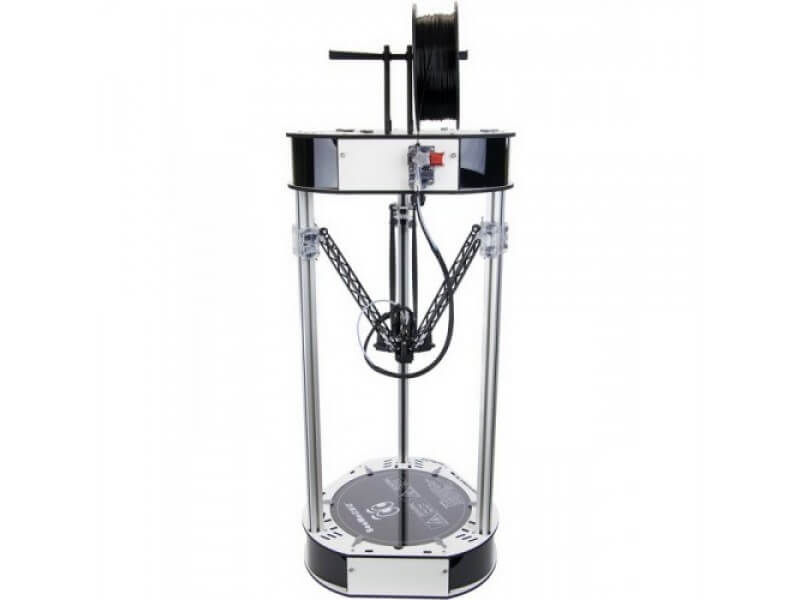
The Rostock MAX v4 printer is an American-made workhorse that can tackle any task you throw at it, all while running so smoothly and quietly that you’ll see why SeeMeCNC is so renowned, and why the 3D printing world adores delta printers.
Because of its laser-like accuracy, our experts have long preferred the Rostock MAX, and the Rostock MAX v4 is the newest and best in the line.
Uses:
- You can print practically any material with the large, upgraded heated bed and incredibly flat borosilicate glass build plate, PLA, ABS, Nylon, and more!
- It also has the SE300 auto-leveling hotend, which ensures consistency and repeatability, guaranteeing that each of your prints is as good as the last.
- Standard 1.75 mm 1lb filament spools are used in this printer. For an expensive printer, the materials you may use are limited.
- Even from rather complex models, the Max v3 is capable of manufacturing high-quality items.
- Although this printer has a small microprocessor, it can be challenging to use.
- On the SeeMeCNC website, there is a good amount of customer support information.
- Can produce detailed models
- Consistency
- Repeatability
- Costly
- Works with limited materials
UltiBots D300VS
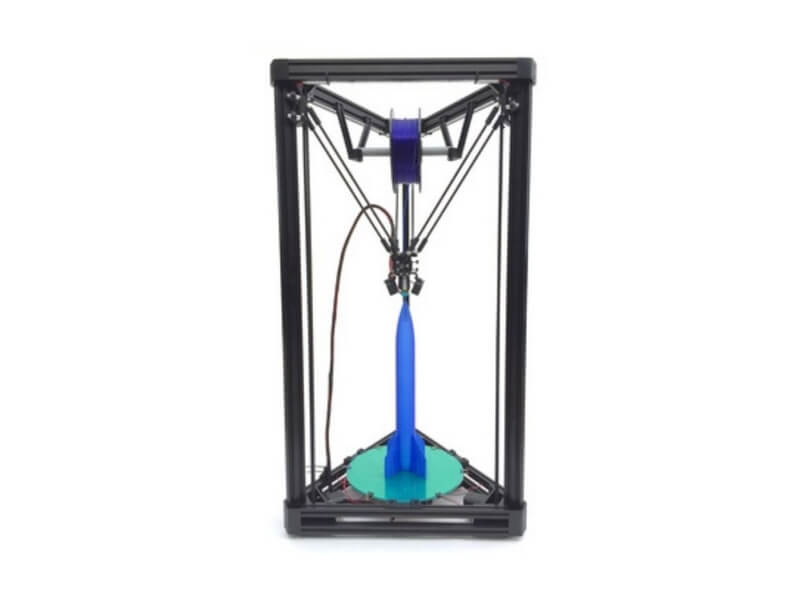
One of the top delta 3D printers on the market is the UltiBots D300VS. The D300VS is an improved version of the D300VS, which is no longer manufactured.
It costs roughly $1,000, making it one of the costliest kits on the market, a distinction that the Rostock MAX v3.2 also shares. The general design focuses on stability, dependability, and precision.
Uses:
- The D300VS, unlike the Rostock MAX v3.2, features a direct feeder mechanism, with the spool holder located above the print head, making it more dependable with flexible filaments.
- It comes with an E3D Titan Aero extruder by default, which has a 0.4-millimeter nozzle and a maximum layer resolution of 100 microns.
- This delta 3D printer comes with an all-metal chassis and heated print bed.
- It offers a large print area, 5-inch LCD controller, and Duet Wi-Fi controller.
- UltiBots provides outstanding customer service.
- It prints quickly and using a variety of materials, including ABS, PETG, and TPU.
- The Assembly process is difficult
- Expensive
Buying Guide
Assembly
Different delta 3D printers come either fully assembled or pre-assembled. The manufacturer assembles the most complicated parts, and after getting the package, you need to install the remaining parts following the instructions provided. Installing those parts should be easy and should not consume much of your time.
Auto-Leveling Of Bed
This function informs the machine that the bed is somewhat slanted, which must be adjusted in order to achieve a smooth initial layer. It also protects the build plate from being struck by the nozzle.
Auto bed leveling is required on Cartesian 3D printers due to the higher frequency of calibration. On the other side, the Delta Mechanism 3D Printing Machines require less frequent calibration, thus it is not a need.
Speed
Because delta 3D printers are designed to print at high speeds, consider purchasing one that prints quicker to save time without sacrificing print quality. This is an important factor to consider.
Recovery of Prints
It is preferable to choose a printer that can swiftly recover from printing prior to the power interruption. This recovery will also save you time from having to print everything over again.
Quick and Easy To Use
If you are a novice or even an experienced user, you may want to look into easy-to-use printers. The ideal printer will allow you to monitor the printer’s progress and performance.
It would be ideal if you looked for printers with easy-to-follow instructions. It will make operating the printer much easier for you.
Frequently Asked Questions (FAQs)
What Is The Best Place To Buy A Delta Printer?
You must now examine your options if you are seeking the best delta printer. Large-scale sellers, such as Amazon, are usually dependable.
You can compare prices and read reviews on Amazon, making your purchase trustworthy. You can, however, purchase straight from the manufacturer. If you want to do so, there are a few things you should be aware of.
To begin, double-check the manufacturer’s customer service and warranty/cash back policies. You want to safeguard yourself if there is a problem.
Second, compare the price on the website to the prices on Amazon, eBay, and Alibaba. If you have a more affordable option, go for it.
What Makes a Delta Printer Different from Other 3D Printers?
The coding scheme used by Delta 3D printers is the same as that used by other 3D printers. The key distinction is that they do not deposit filaments in a consistent manner.
A Delta 3D printer, as previously stated, has three arms. The filaments are deposited at varying angles by these arms, making the motions more exact.
Delta printers are also lighter than other 3D printers due to their design. If you understand basic physics, you will notice that this minimizes inertia, making motions faster and more fluid.
For A Delta 3D Printer, What Filaments Should I Use?
ABS, PLA, PVA, HIPS, or wood are the most common materials used in delta 3D printers.
Is It Okay If I Leave My 3D Printer Alone While It Works?
It is preferable to keep an eye on your 3D printer while it is in use. It’s possible that the printer bed will overheat and run out of filaments. This could cause problems with your printing job.
Is It True That 3D Printers Use A Lot Of Electricity?
These printers are energy efficient, enabling you to save time and money.
Conclusion
Overall, you can select the best delta printer by assessing how well it operates and how well it meets your requirements. Whether you’re new to 3D printing or a seasoned pro, we hope you found this list useful.
You must conduct research when seeking the best delta printer. We hope that by reading this article, you will be able to make an informed decision.
We hope that after reading our list of the fifteen top Delta 3D Printers for 2021, you can pick one that meets your requirements. And, in order to understand your requirements, you’ll need to ask yourself questions about the build volume, print quality, print speed, and budget.
After that, you’ll need to add up the answers and find the printer that is closest to your final answer. This is a reasonable approach to reaching a decision. You, on the other hand, are free to go your own path.

